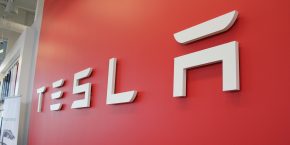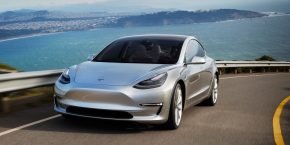

Tesla CEO Elon Musk finally released more details about the reservations process for the upcoming Model 3 launch and it gives us an interesting opportunity to discuss the implications of the vehicle’s introduction on Tesla’s limit for the $7,500 federal tax credit for electric vehicles.
We’ve heard some discussion in EV industry about the implications of GM advertising the Bolt’s pricing as “$30,000 after incentives” and in contrast, Tesla is talking about the Model 3’s starting price as being “$35,000 before incentives”.
Anyone in the US who mildly follows the EV scene is aware of the $7500 Federal tax credit that is awarded to new EV buyers. On top of that, US States contribute anywhere from $0 to $6000 more in tax incentives as well as other things like riding in carpool lanes and other niceties.
For the sake of simplicity, it would be best for GM to stick to the price before EV incentives when talking about the Bolt, but in Tesla’s case, it’s not just about simplicity. There’s a real risk that some, if not most early Model 3 buyers in the US will simply not have access the $7,500 Federal tax credit.
Under the current program, it runs out after 200,000 sales per maker from the program’s start in 2009. Then it tapers off quickly over one year after reaching the threshold.
It’s difficult to estimate exactly when Tesla will it the threshold since the automaker rarely breakdown its sales per market, but I’ve put together a projection that should be fairly accurate. It depends on how fast Tesla will be ramping up its production and how strong of a market the U.S. will remain in the near future for the company, but I feel confident that Tesla should hit the 200,000 cumulative sales mark in the U.S. during the second half of 2018.

The US Law states that after 200,000 is reached, customers will receive $3,750 for the following 6 months with no apparent limit on units. The following 6 months after that, only $1,875 will be awarded to car buyers. That means that for most of 2019 Tesla buyers won’t likely have much federal incentive to buy cars. By 2020, the Federal Subsidy will have run out.
We are assuming that the program will not get an extension, but whether or not that happens will depend largely on the political climate which will be decided at the elections in the US this year. Since it is a big unknown, let’s assume it doesn’t get extended and runs out when Tesla sells its 200,000th US electric vehicle.
What are the implications for the Model 3?
If Tesla brings the Model 3 to market on time in late 2017, it will mean that buyers will profit from the federal tax credit for just about one year before it runs out. Now the important question is: how fast will Tesla sellout the first year of Model 3 production?
It’s anyone’s guess and you can answer our poll below to make yours, but here at Electrek, we all agree that the first year of production will get booked fairly quickly in the reservation process.
As Seth wrote this morning, with a lower than expected required deposit of just $1,000 and the strategy of first allowing in-store reservations on March 31st and then online the next day, Tesla could create an iPhone-like buzz around the product and spur early reservations. Of course, it will all depend on what Tesla will show at the Model 3 unveiling next month, and CEO Elon Musk said that he has yet to decide if he wants to show “all his cards” right away, but I honestly wouldn’t be surprised if Tesla manages to get 100,000 reservations by the end of the year and sellout the first full year of Model 3 production a year before its market introduction.
We want to know your opinion about this so please vote in the poll below and share your thoughts in the comment section.
Featured Image: Model 3 concept art by charging station maker Easy Charge
FTC: We use income earning auto affiliate links. More.





If this looks anything like a smaller Model S (i.e. a sporty sedan) they’ll likely sell out production for all of 2018. If it goes tall, boxy, and goofy like every other EV, then all bets are off. Don’t screw this up Tesla…
Thankfully we already know it’s going to be the former…or something far closer to that than a box. They’re going for the lowest possible drag coefficient so boxy is definitely out of the question.
You should just call this site “TeslaTrek”. (not complaining or anything 😀 )
I only follow them for that very reason xD I wish they would do a “9to5Elon”
Hi Fred. Did you estimate 50% Global sales for all years, 2015 and prior? If so, I think the US numbers would then be understated. I think it would make better sense if you front loaded the early years towards less than 50% of Global sales especially years 2012 and 13.
Yeah it’s not in each year up to 2015 but average out to just a little less than 50% of global deliveries for the first 4 years. You are probably right, but these numbers are so low compared to the 2016 and up projections that it really wouldn’t change anything since we are not really pinpointing an exact hit for the threshold, but really just saying H2 2018.
Cool, yeah agree will not hit the needle much and still looking to a phase out by late 2018. Do you know of any petition that might make the Fed increase the cumulative US sales higher than 200K? This is one petition I can support. Thanks!
So will a early reservation determine your delivery date or the specs you choose on the model 3? This tax credit is a big deciding factor for me. There is no need to go for a early reservation if it doesn’t help you secure a early delivery date (I.e better chance at the tax credit).
From article above: “The US Law states that after 200,000 is reached, customers will receive $3,750 for the following 6 months with no apparent limit on units.”
Sorry this information is not 100% accurate. The phase out period won’t begin until at least 3 months after 200,000.
From IRS website:
Qualified Plug-In Electric Drive Motor Vehicle Credit (IRC 30D) Phase Out
The qualified plug-in electric drive motor vehicle credit phases out for a manufacturer’s vehicles over the one-year period beginning with the second calendar quarter after the calendar quarter in which at least 200,000 qualifying vehicles manufactured by that manufacturer have been sold for use in the United States (determined on a cumulative basis for sales after December 31, 2009) (“phase-out period”). Qualifying vehicles manufactured by that manufacturer are eligible for 50 percent of the credit if acquired in the first two quarters of the phase-out period and 25 percent of the credit if acquired in the third or fourth quarter of the phase-out period. Vehicles manufactured by that manufacturer are not eligible for a credit if acquired after the phase-out period.